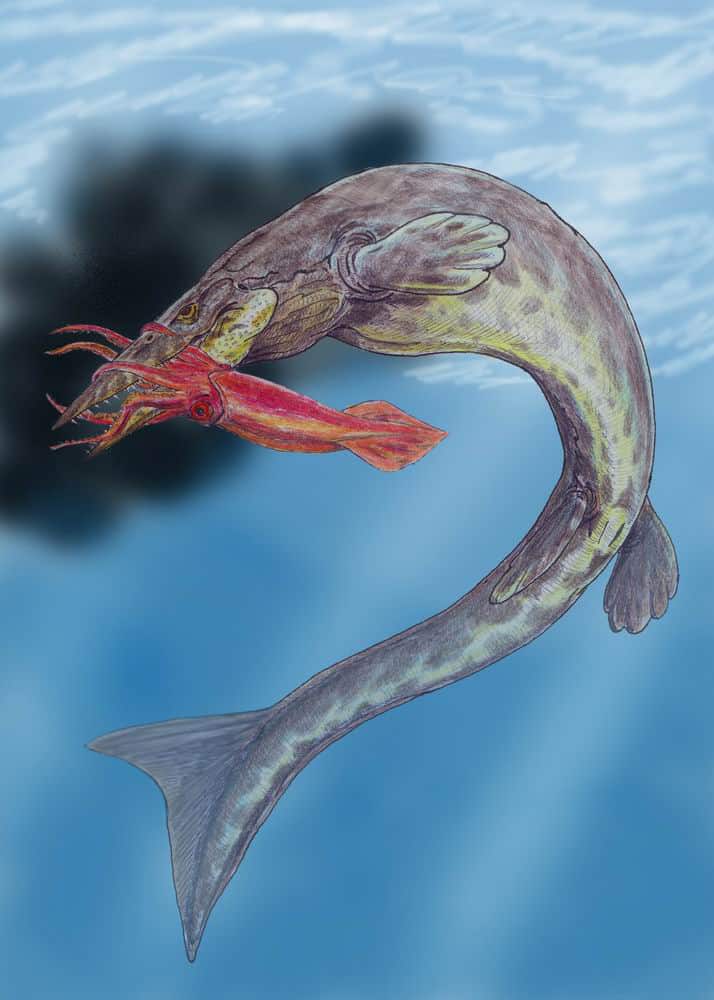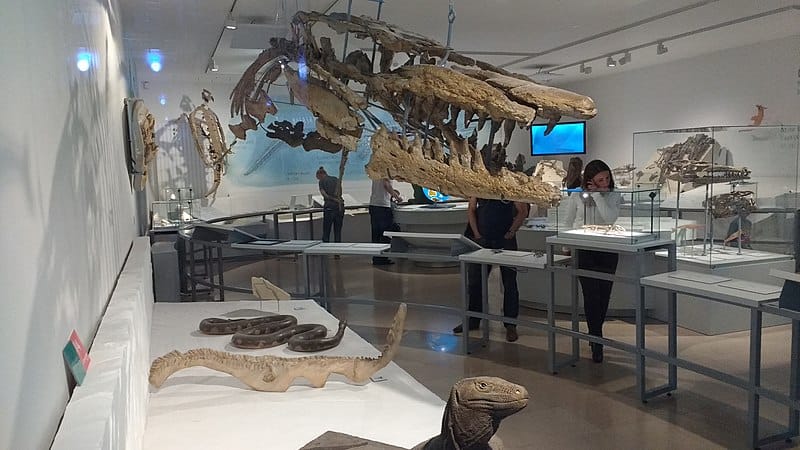What was close to 40 to 45 feet long with a long neck and tail, had four flippers, giant jaws, swam through the water like a fish, and devoured sharks whenever it was hungry? The ancient, extinct marine predator, Hainosaurus, of course!
Hainosaurus is one of the most interesting prehistoric animals ever discovered. This marine predator lived in the Late Cretaceous period, 100.5 million years ago to 66 million years ago. While they lived in the sea, scientists think Hainosaurus preferred to stay in the shallow water and only dove into the ocean depths to hunt for prey.
Their first fossil remains were found in a Ciply chalk quarry in Belgium in the year 1885. Ciply chalk is phosphatic chalk they used for agriculture and to make bricks named for a village in Belgium in the Hainaut province. Even though it was an active quarry, the owner allowed the scientists to access the remains and remove them safely.
In thanks, they named the large creature after the Belgium province where it was found. The name Hainosaurus combines the Belgium province, Hainaut, with the Greek word for lizard, ‘saurus.’
Hainosaurus is a Genus of Mosasaurs
Hainosaurus belongs to a group called mosasaurs, which were all aquatic reptiles that went extinct 65 million years ago. Imagine the oceans filled with giant, fast-swimming reptiles that could eat almost anything!
Mosasaurs lived at the same time as dinosaurs but were not land-based animals. Researchers think they might have evolved from an extinct group of aquatic lizards known as aigialosaurs.
Although the relatives of mosasaurs alive today are much smaller, mosasaurs can be considered the “cousins” of modern-day snakes and monitor lizards.
Hainosaurus were Giant Marine Reptiles

The Hainosaurus is thought to have been the apex predator during its time.
©Dmitry Bogdanov / public domain – License
At 40 to 45 feet long—which is about the length of a school bus—these giant marine reptiles were not even the biggest mosasaurs swimming in the oceans at the time. These predators had a long body, with a tail that ended with a fin. Like other mosasaurs, they would use their tails to accelerate in bursts of speed when they wanted to attack their prey.
During the peak of their existence, the Hainosaurus was at the top of the food chain. Most of the other creatures alive at the time could not challenge its size and strength.
Scientists estimate that many of these marine reptiles were either blue or greenish-blue in color with black stripes along their bodies and heads. It is possible that there were different species of mosasaurs, aside from just the Hainosaurus. It is believed that there may have been several different subspecies within each species. Basically, a variety of giant marine lizards that lived all over the oceans.
Mosasaurs were not Dinosaurs
Although giant in size and alive at the same time as the dinosaurs, mosasaurs, such as the Hainosaurus, weren’t dinosaurs. They were reptiles more closely related to monitor lizards and snakes than to the land-dwelling dinosaurs that came before them.
Some mosasaurs may have weighed as much as 15 tons, which is the equivalent of two to three adult elephants. To keep up their size, they had to eat a lot of anything they could find. This mostly consisted of sharks, fish, sea turtles, plesiosaurs, and ammonites, which were extinct marine mollusk animals. Their jaws were so powerful that it is thought they would crush their prey into pieces and swallow the pieces whole.
Hainosaurus Fossils Have Been Found in Europe and North America

Remains of the huge Hainosaurus
©Fernando Losada Rodríguez / Creative Commons Attribution-Share Alike 4.0 International license – License
Fossils of this ancient marine predator have been found in Canada, Germany, France, the Netherlands, and the UK, to name a few places. Although most of the remains paleontologists discovered were only partial, the Hainosaurus remains were often uncovered alongside marine life that it would have eaten. Researchers know the Hainosaurus had a powerful jaw and a large body because many of the pieces of sharks, fish, sea turtles, plesiosaurs, and ammonites found with the Hainosaurus remains were partially intact.
How Hainosaurus Hunted
In the past, it was believed that Hainosaurus hunted and ate their prey the same way as a great white shark. However, recent studies have shown that this is not the case. Instead, Hainosaurus hunted its prey by swimming towards them and lunging forward with its jaws open. This would have been effective against smaller prey but not so much against larger ones.
To catch such larger prey, Hainosaurus had to use a different strategy entirely. It would swim towards them and then rear up on its tail to use the force of gravity to bring down its head onto the top of its prey’s body. This allowed Hainosaurus to catch larger prey while still using its jaw-based method of attack against smaller ones.
In his 2005 report, paleontologist Johan Lindgren described the teeth of the Hainosaurus. He said the rows of teeth were strongly compressed and finely serrated—like little knives. It could also use its powerful teeth to bite off chunks of flesh from larger animals more effectively than many of its relatives. The wear found on the fossilized remains of the teeth indicates the Hainosaurus was regularly contacting bone as it bit into its prey.
They Thought That the Hainosaurus Was Bigger

Estimates put the Hainosaurus at around 40 feet long
©Ghedoghedo / Creative Commons Attribution-Share Alike 4.0 International license – License
Without the complete remains of a Hainosaurus, researchers have been estimating its total size. When the first partial remains were discovered in 1885, the Hainosaurus was estimated to be 56 feet long and the largest mosasaurs.
During the 1990s, more remains were found, and scientists reduced its estimated size to 49 feet long. In 2005, a Swedish paleontologist named Johan Lindgren analyzed some remains he found and proposed a total size of 40 feet.
A complete fossil record would help researchers more precisely describe the exact size of the giant Hainosaurus. Since the remains found so far are not complete, they have to use what they have to estimate the total size of this ancient giant.
Ancient Giant Reptiles Used to Dominate the Ocean
If you sail or swim in the ocean, you know it is vast and deep. The total water mass of the Earth outweighs the total land mass, meaning that there is more ocean than land. Plus, the ocean has immense depth in addition to its width. It’s hard to imagine from the shore, but the oceans are teeming with layers of life.
In the ancient days of the dinosaurs, the seas were filled with enormous, fast, carnivorous reptiles. Can you imagine if they were still here today? The sharks that swim in the ocean present enough danger. However, they are mostly small and docile compared to these giant marine reptiles that dominated during their day.
The Hainosaurus left their mark with many fossil remains. In real life, they were probably remarkable to see.
Up Next
The photo featured at the top of this post is © Dmitry Bogdanov / public domain – License / Original
FAQs (Frequently Asked Questions)
Is Hainosaurus a Tylosaurus?
The Hainosaurus is related to the Tylosaurus and both were giant marine superpredators. The Hainosaurus had 53 vertebrae from the neck through the tail while the Tylosaurus only had 35.
What did Hainosaurus eat?
The Hainosaurus would eat anything it could sink its teeth into including sharks, fish, turtles, cephalopods (similar to squid or octopus), pterosaurs (now extinct flying reptiles), plesiosaurs (now extinct marine reptiles), and other, smaller, mosasaurs.
What is the largest mosasaur?
The biggest mosasaur identified so far was the Mosasaurus hoffmanni which may have reached lengths up to 57 feet (about 9/10 of a bowling lane).
What was the biggest marine dinosaur?
The Shonisaurus sikanniensis may have been the largest sea animal alive during the age of the dinosaurs. Researchers estimate is was an astonishing 85 feet long (the length between two bases in professional baseball).
Thank you for reading! Have some feedback for us? Contact the AZ Animals editorial team.






